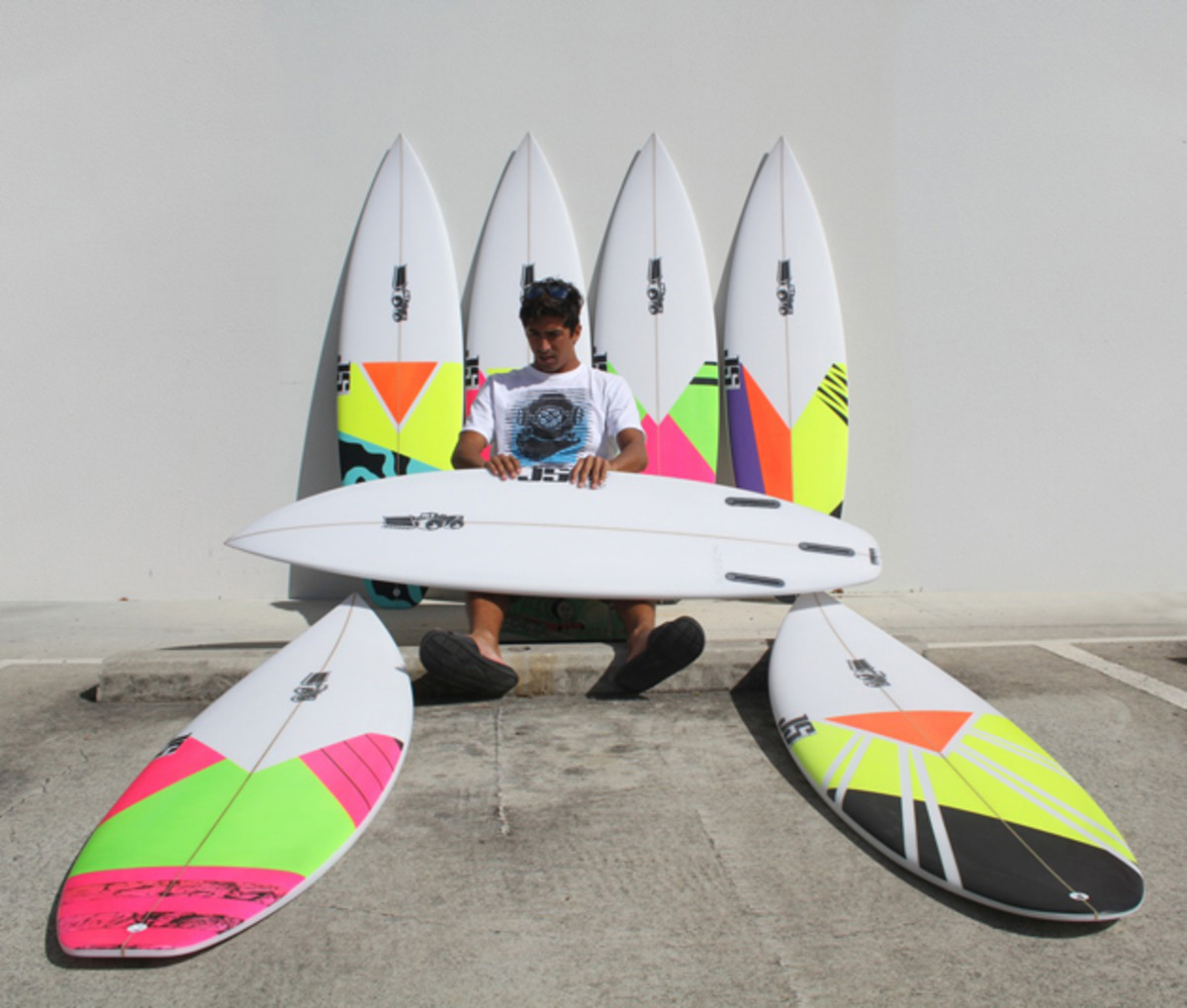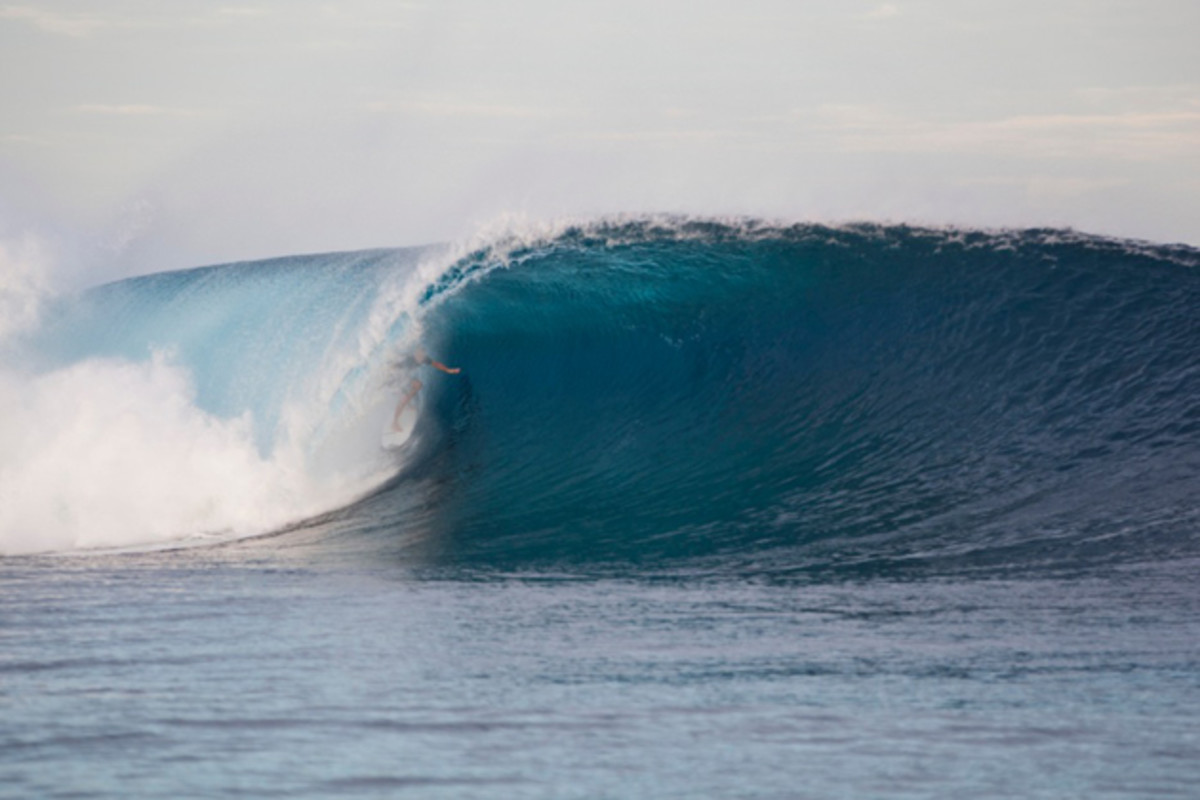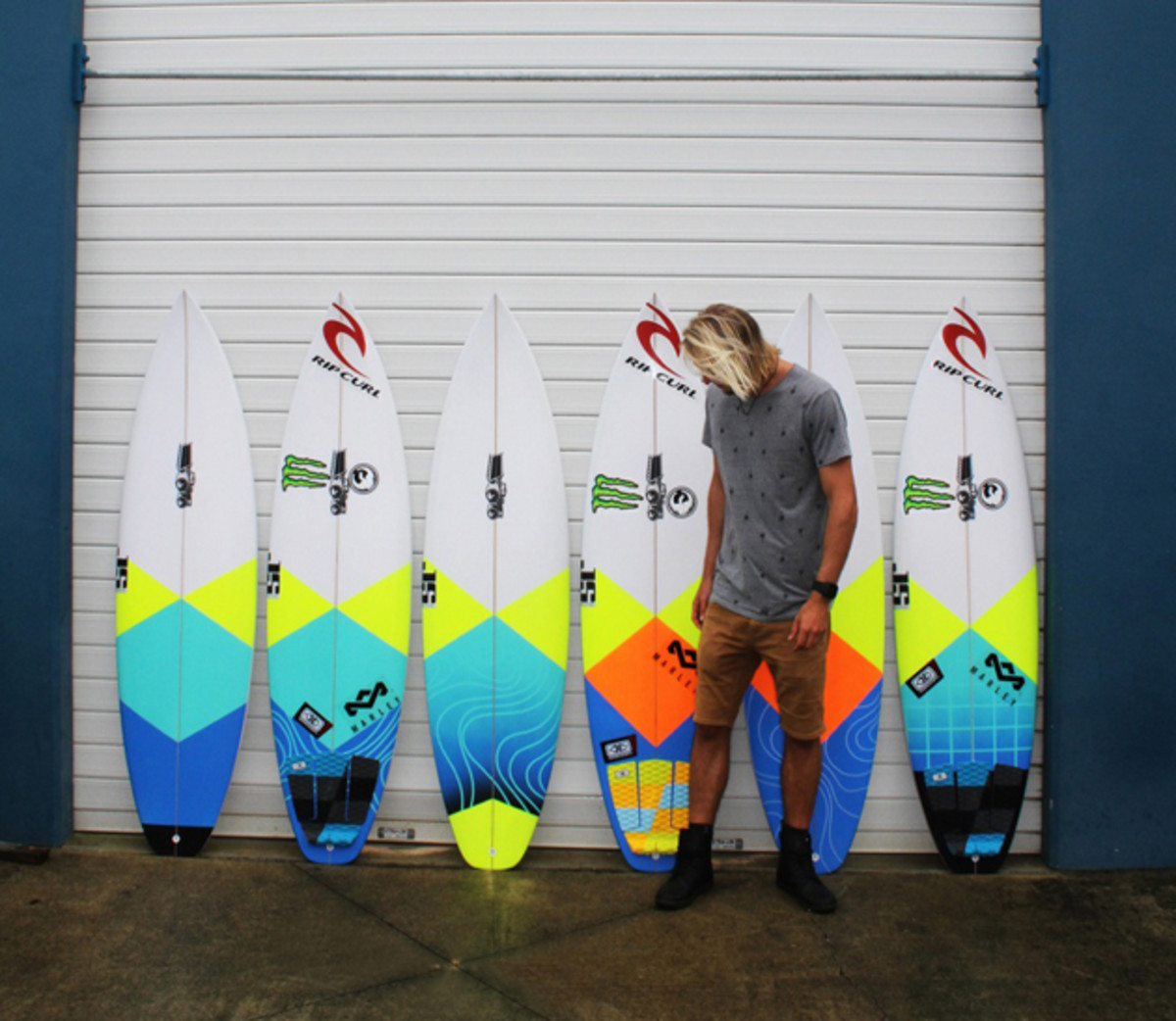The Shape of Success: The artist—and rider—behind JS Surfboards

Jason Stevenson has the perfect reply when friends ask him why he surfs so much.
“Every time I’m out there it’s research and development,” he says with a chuckle.
After all, he has to test his products.
Stevenson is the man behind the brand of surfboards under the feet of some of the world’s best surfers. JS Industries’ current roster of team riders reads like an all-star cast: Joel Parkinson (2012 World Champion), Owen Wright (World No. 3 in 2011), and Ace Buchan (2013 Billabong Pro Tahiti Champ), just to name a few.
That list doesn’t include a host of other world tour surfers, from Miguel Pupo to Julian Wilson or CJ Hobgood, who aren’t team riders but still get boards from Stevenson—all with the hope of finding that magic craft they’ll ride to a podium finish.
Demand reaches its crest this week during the Quicksilver Pro on Australia’s Gold Coast. The contest site at Snapper Rocks is just a short walk from Stevenson’s factory, and he has surfed the break for over twenty-five years. It’s that local knowledge combined with JS’s global reputation that has tour pros texting him orders for five, seven, even 10 boards months in advance.
[daily_cut]Stevenson estimates that he and his team of shapers have made 80 boards for the Top 34 for the Quick Pro.
“Most of the top guys on tour will be on a JS at the first event,” says Wright. “He knows the wave better than anyone else and there is just so much buzz about how incredible his boards are. A lot of the competitors will head straight to his factory after they get to Australia to pick up boards.”
Wright, 25, from Culburra Beach, New South Wales, is one the most recent converts to the JS brand. He signed on as a team rider this past December. After suffering a disc injury in April 2013 that kept him out of the water for eight months, Wright decided to re-evaluate his surfing and make a “fresh start.”
The new approach began with his equipment. Last February before the Quicksilver Pro, Wright tested boards from every high profile shaper. The consensus?
“JS was the best all the way,” he says. “They just felt amazing. When you grab and ride a JS you just feel like you’re surfing sexy. You never bog or catch a rail. His boards are seamless.”
Such accolades from one of the world’s best stems from the two decades Stevenson has spent honing his craft and building a brand from scratch.
****
Stevenson, 43, grew up by the ocean on North Stradbroke Island, just off the coast from Brisbane. He started surfing when he was five and became sponsored by Pipedream surfboards before he had his driver’s license.
Yet, with few contest results and his future as a professional surfer in doubt, Stevenson knew he had to find his next wave. He wasn’t sure where to turn. “Surfing was my life,” he says. “That’s all I knew.”

When he was 23, Stevenson moved to Coolangatta on the Gold Coast—Australia’s epicenter of surfing. He talked his way into a job at the Pipedreams factory and began an apprenticeship with renowned shaper Murray Bourton. Stevenson watched and started to learn the basics of the trade—how to use a planer, how to turn a rail, how to cut an outline.
A year later he was tired of watching. He wanted to try shaping for himself. So one day Stevenson picked up a foam blank, snuck into one of Bourton’s shaping bays and started experimenting.
The initial product? “It wasn’t very good,” Stevenson says with a laugh.
While the result might have looked more like a high school art project than high-performance craft, Stevenson was hooked, just as he was after his dad pushed him into his first wave.
“It’s a unique feeling being able to make something with your hands then get to ride it,” he says. “I love it. That’s why over 20 years later I’m still doing the same thing.”
*****
So Stevenson didn’t quit after his first attempt, and after four years working for Darren Handley Designs, he started his own brand.
There was one problem. He needed a logo. While most surfboard brands opt for the shaper’s name like “Al Merrick” or “Rusty,” Stevenson wanted an icon that would set his boards apart.
The search led him to an unlikely destination. Toys R Us. But Stevenson found what he was looking for—a toy tractor. The decal appears on every JS surfboard and serves as tribute to his blue-collar origins. (His father used to operate machinery at the salt mines on North Stradbroke.)
Swell Matters: The wave science behind Mavericks
The breakthrough for JS’s“Traktors” though didn’t happen until 2003 when Dean (Dingo) Morrison, Stevenson’s first team rider, won the Quicksilver Pro. Others noticed. The win prompted Luke Egan, then ranked No. 2 on the WCT, to ask for a few boards. More followed.
“Luke really opened the floodgates,” Stevenson says.
From Sunny Garcia to the Irons brothers, everyone wanted their own lot of Traktors. The recognition vaunted Stevenson’s credibility and today JS industries remains one of the world’s most sought after surfboard brands for tour pros.
But JS caters to more than surfing’s one percent. For those who aren’t chasing world titles or surfing world-class waves, JS’s “X” and “Summer” series models are designed with average waves and skill levels in mind. The boards feature a wider outline and extra volume for easier paddling and a more forgiving ride.
“JS boards are without a doubt our best seller,” says Pito, a shop employee at Aloha Manly Style—a surf shop outside of Sydney. “He is the number one shaper in Australia.”

Although Stevenson’s sales in the U.S. don’t quite match those down under, the brand’s cachet has also crossed the Pacific and is based on more than hype.
“Sure, JS has a great team of riders, but their boards are also proven to work,” says Matt Brown, the shop manager at Encinitas Surfboards in California. “When you spend $600 or $700 on a board you want to know that it’s going to work and you’re guaranteed that with a JS. They have a really good-quality product.”
*****
But despite the fact that JS boards have won contests from South Africa to Hawaii or that they’ve appeared on more surfing magazine covers than the world’s most famous swimsuit models, Stevenson doesn’t stand out in a crowd. You won’t find him on any advertisements or in front of the cameras. At contests, he usually stays behind the scenes and dons a black trucker hat and large sunglasses.
He lets his boards do the talking.
How the world’s top big wave surfers get ready for the sport’s biggest event
And what few spectators realize when they see Joel Parkinson pull into a barrel or Julian Wilson land an air reverse is the amount of effort behind constructing the pieces of foam and glass the surfers use to take the sport to new heights.
Stevenson’s job might seem like a fantasy. He gets to surf around the world and has surfing’s stars on speed dial. Yet he spends most of his day hunched over in the confines of his windowless shaping bay.
He usually wakes up before dawn, checks the surf and makes the short commute to JS Industries. The company boasts one of the most sophisticated shaping factories in the world, and advances in technology, including Computer Assisted Designing (CAD) programs, have drastically reduced the amount of “back breaking” labor required by shapers. But Stevenson still gets his hands dirty. And his work space—with its royal blue walls, the constant whirring of planers and sandpaper, the piles of foam dust that mount as he whittles away on a board—isn’t exactly five-star accommodations.

“It’s dusty, it’s gritty,” Stevenson says. “It’s hot and it’s sticking and by the end of the day you have foam dust stuck all over you.”
But seeing and feeling the finished board is worth it.
“Other people who build different products don’t get to see the end result like I do,” he says. “I like getting down and dirty in the shaping bay, because once I’m done I jump in the ocean for a surf on a board I made. “
While Stevenson might not sport a singlet at a contest, he still feels the rush of competition watching tour pros ride his boards. “We shapers are no different than the athletes,” he says. “We want to be better than each other and have our guys win.”
“It’s like a stamp on the hard work you’ve done,” he adds about having a surfer win a contest on a JS. “It’s very, very satisfying.”
One instance stands out. Stevenson’s proudest moment came when Joel Parkinson won the 2012 world title after four runner-up finishes in his previous 11 seasons. Stevenson first met Parkinson during trips down to the Gold Coast for local contests when he was a teenager, and Parkinson has been a JS team rider since 2005. But the relationship goes beyond business. The two live less than two miles apart. They surf together at least five days a week when Parkinson is home. Their families go on vacations together to such destinations as California and Fiji.
“He was more excited than I was on the win,” Parkinson says of Stevenson, who was one of the first to embrace him on the shoreline at Pipeline when he clinched the title.
And Parkinson knew the perfect way to repay his “best mate” for the over 100 boards Stevenson shapes for him each year and countless hours he invested to help him finally hoist the world championship trophy. Back in Coolangatta, Parkinson stopped by the JS factory and presented Stevenson with the 6' 3" “Forget Me Not” model that he rode to victory at the Pipe Masters.
The board, with its smooth outline, Traktor logo and Stevenson’s initials, is the first thing you see when you step into his office. But don’t expect Stevenson to take this board out for a test drive anytime soon.
“It’s a little piece of nostalgia,” he says. “It’s my trophy.”
